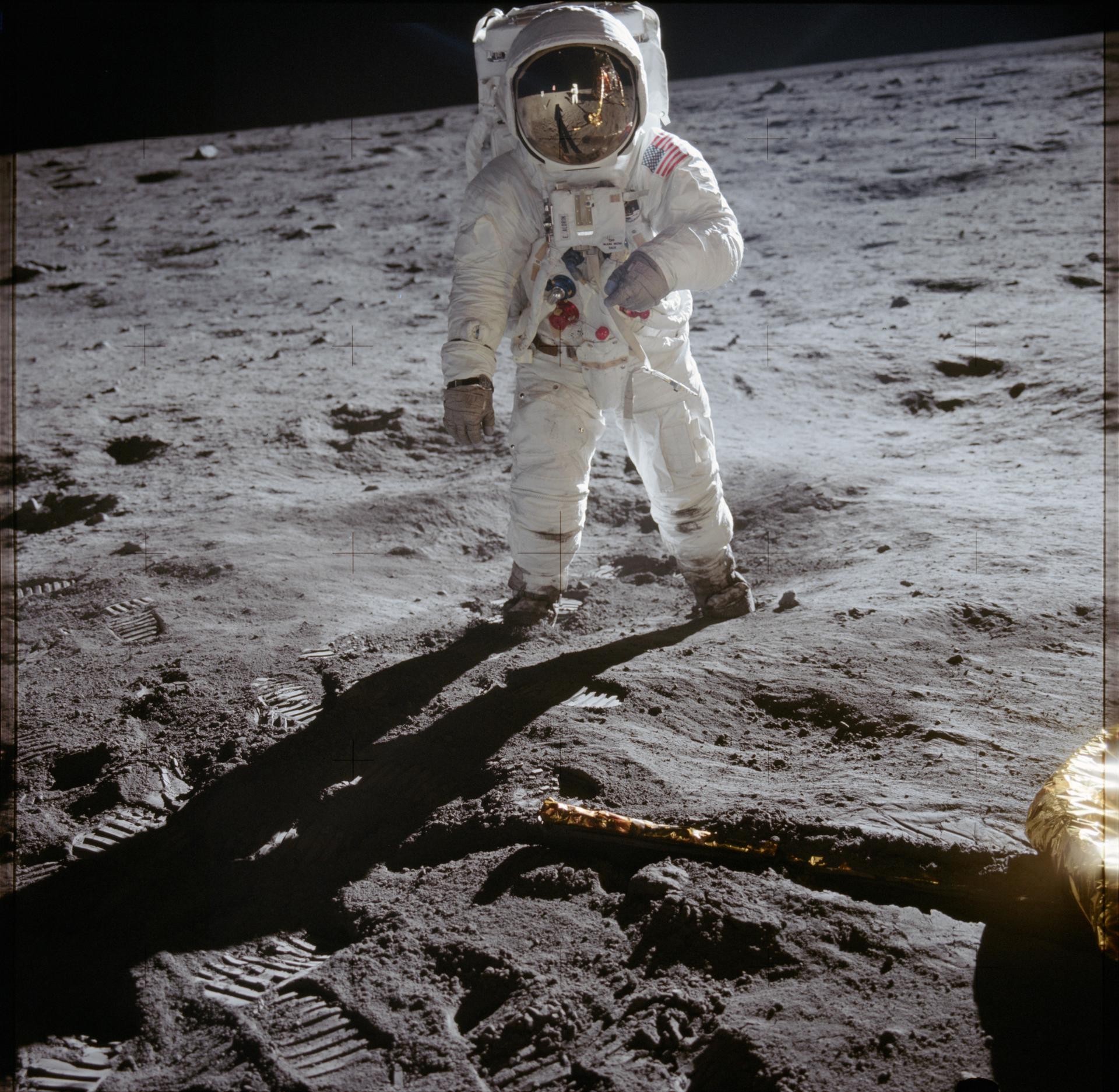
The Space Race
In 1969 two men from America climbed down a ladder. Not much of a story really, except when they stepped off that ladder they became the first human beings to set foot on another world. This was an incredible moment that captured the attention of the world and even now, so many years later, remains one of the high points of human achievement.
Not only was this a spectacular event in the history of the human race, it was also the culmination of the space race, the race between the Soviet Union and the United States of America to be the first nation to land human beings on the moon and bring them home safely.
This is the story of great bravery and tragedy, of great feats of engineering and science to overcome incredible odds and achieve what seemed impossible.
This is the story of one of the most remarkable periods of human endeavour and exploration.
This is the story of THE SPACE RACE.
Chapter 1 - The Race Begins
Towards the end of the second world war, Nazi Germany had built some of the most sophisticated rockets in the world. These V2 rockets were fired at London in a last ditch attempt to turn the tide of the war.
One of the chief designers of these rockets was Dr Wernher Von Braun. When told of the first V2 hitting London, Von Braun remarked "The rocket worked perfectly except for landing on the wrong planet". Von Braun's dream was to launch his rockets into space but the nazis wanted him to build their weapons of terror.


At the end of the war, Von Braun and his team of rocket engineers surrendered to the Americans and were put to work on the American missile program.
The nuclear age had begun and America and Russia were locked in the Cold War. Both sides realized the importance of rockets to deliver nuclear warheads so Von Braun again found himself designing military hardware.
He still had ambitions for building space rockets and he realized that the army's Redstone rocket could be modified to launch a small satellite. He argued his case but his ideas fell on deaf ears.
In Soviet Russia, Von Braun's opposite number, Sergei Korolev had the same idea of launching a satellite on a modified version of the R7 rocket. However, unlike Von Braun, Korolev's superiors were prepared to listen.
Chapter 2 - A Shock to the System
By 1957 the world's scientists had begun to talk about the possibility of launching a small satellite or probe into space. The Russians believed they were ready to do this and told the world of their plans. However, America was the most technologically advanced country in the world and if a satellite was going to soar into space, surely it would be launched from Uncle Sam's backyard.
On 4th October 1957 a news release from Russia swept around the world. Teleprinters across America's newsrooms hammered out the message. The Russians had launched the world's first satellite, Sputnik. If that news wasn't bad enough, it was also flying directly over America. American skies had been violated.

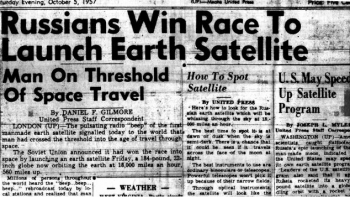
President Eisenhower tried to pacify an indignant America by claiming "The Russians have only put one small ball in the air". The Soviet premier Khrushchev saw things differently "The people of the world are pointing to the satellite and saying the US has been beaten".
30 days later the Russians launched a much larger satellite but the astonishing thing about Sputnik 2 was not its size but what was on board.
Inside the satellite was a dog, Laika. The Russians had put the first living creature into space. This time instead of the steady electronic beep of Sputnik, the world listened to a heartbeat.
The Russians had no intention of retrieving Laika and after a few days the oxygen in Sputnik 2 ran out and she slipped into hypoxic sleep and died painlessly.
The American public wanted to know why the United States were so far behind the Russians. They wanted to see a satellite with the Stars and Stripes on the side.
In January 1958, after a number of failed attempts, the American public got what it wanted when one of Von Braun's rockets launched Explorer 1 into orbit. With both the world's super-powers up and running with their space programs, the next step was to put a man into space.
After an exhaustive program of selection, seven test pilots were chosen to be America's pioneers in space. The press and the public were introduced to America's first astronauts,
the Mercury Seven.
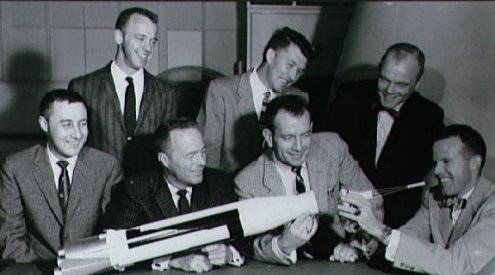

Gordo Cooper, Scott Carpenter, John Glenn, Alan Shepard, Gus Grissom, Wally Schirra and Deke Slayton were the 7 astronauts who went through an exhaustive programme to become the astronauts for the Mercury flights.
With both the Soviets and the Americans now running space programmes, the big question was:
Which nation would be the first to put a man into space?
Chapter 3 - Are You from Outer Space?
In April 1961, in a field near the village of Smelovaka in Russia, two farm workers look up to see a man parachuting down towards them. There was no sign of any aircraft, he just seemed to appear in the sky out of nowhere. He was wearing a bright orange suit and a white helmet. When he lands, with great trepidation, the farm workers approach him and ask "Have you come from outer space?"
"Yes, yes, would you believe it' he answered with a big grin, "I certainly have".
The man in the orange space suit was Yuri Gagarin and he was indeed returning to earth after becoming the first man to travel in space. Sputnik had been a great achievement and a ground-breaking event but this was far better. The Russians could present the first cosmonaut to the world's press. Yuri Gagarin was sent on a global tour, not just as a hero of the Soviet Union, but as a hero of the world. Everyone wanted to meet the world's first spaceman.
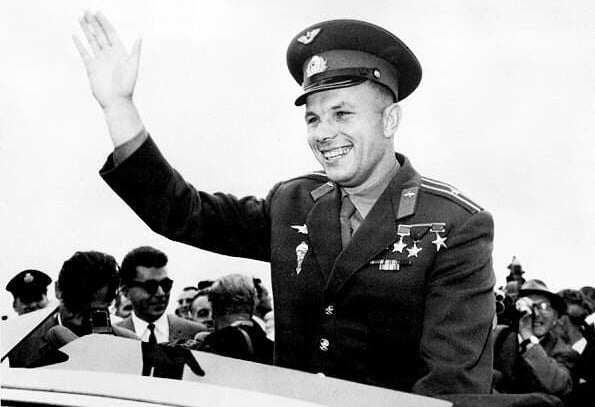

Alan Shepard had been selected by NASA to be the first of the Mercury 7 to travel in space and Shepard fully expected to be the first human to do so. Instead he was woken up in the middle of the night by a phone call from a NASA official, "They've done it, the Russians have put a man in orbit".
John Glenn, another of the Mercury 7 astronauts, summed up the dark mood around NASA, "They beat the pants off us, that's all. There's no kidding ourselves about that".
In Washington a new young president, John F Kennedy, had to decide whether to concede space to the Russians and accept their technological superiority or to try to beat them in a space race.
Politically Kennedy was under a lot of pressure after the fiasco of the failed Bay of Pigs invasion of Cuba. He knew that he needed to make a bold statement to the American people.
On 5th May 1961 Alan Shepard was carried into orbit in the Freedom 7 spacecraft. Unlike Gagarin's complete orbit of the earth, Shepard's flight was much shorter. The whole flight lasted just fifteen minutes and Shepard splashed down just over 300 miles away.
Despite the flight being so brief in comparison to Gagarin's, America now had it's own astronaut and Shepard became a national hero.
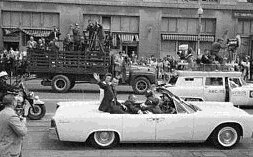

Twenty days after Shepard's flight, the Mercury astronauts gathered in the pilots office at Langley Airforce Base to listen to Kennedy's speech to congress regarding the future of the space program.
Kennedy's speech was emphatic.
"I believe this nation should commit itself to achieving the goal before the decade is out of landing a man on the moon and returning him safely to earth".
Back at Langley air force base the astronauts listened with disbelief. The idea of a slingshot around the moon was ambitious but the president had just announced that America was going to land a man on the moon.
Gordo Cooper turned to the others, "It just ain't possible. First we don't have the rockets, second we don't have the spacecraft and third by god we don't even know how to navigate our way out there and back". Deke Slayton, a former air force pilot replied "Hey Gordo, don't forget Kennedy's a navy man like Shepard. We've got only 15 minutes flying time in space and now he figures he could just get us a road map, or we can follow the rail tracks all the way to the moon. That's the way a navy pilot would get us there, following the rail tracks".
Gus Grissom was more succinct, "the president is nuts".
Whatever the feeling among the astronauts, the space race now had a finishing line:
Landing a man on the moon.
Chapter 4 - The Heat is On!
In order to learn about sending men into orbit, America had embarked on project Mercury. The small Mercury capsule was capable of taking one astronaut into orbit. Unlike the Russian Vostok spacecraft, the Mercury capsule could actually be steered in space and the astronauts could enjoy piloting the craft in space. Alan Shepard had flown the first Mercury mission. It was now the turn of Gus Grissom to fly the second.
Grissom's flight would be a duplicate of Shepard's. This flight would have its problems, not in space but on the ocean.
Shortly after splashing down in the Pacific, the charges on the escape hatch blew and the hatch flew open. As the capsule pitched on the waves it quickly started to take on water and within seconds had disappeared, sinking to the ocean floor. Fortunately Grissom had been able to scramble out and was winched to safety.
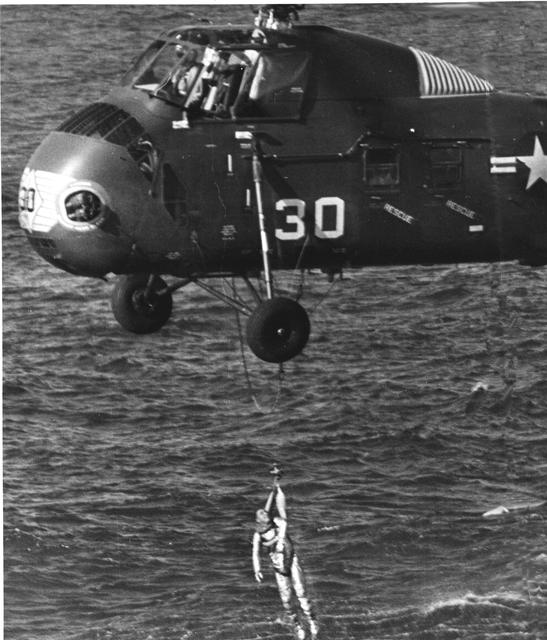

Sixteen days after Liberty 7 had sunk to the bottom of the Pacific, the Russians sent one of their huge SS-6 boosters skyward carrying Major Titov aboard the spaceship Vostok 2.
Titov stayed in orbit a full day. The Russian cosmonauts now had over 24 hours flying time in space, the Americans about thirty minutes.
At this point in the American space program the Redstone boosters had served their purpose but the more powerful replacement, the Atlas was proving unreliable. Two out of every three launches ended up with the Atlas rocket exploding in flames. There was not a long queue of astronauts waiting to ride one into space.
However by September 1961 the engineers felt they had cracked the problems and in February 1962 John Glenn was the first astronaut to be fired into orbit by the new Atlas booster. Glenn also became the first American to complete a full orbit in space. The flight though didn't go to plan.
While Glenn was marvelling at the views of earth, a full scale emergency had developed at mission control. Sensors indicated the heat shield that would protect Glenn from frying in the 4000 degree re-entry burn up might have come loose. If it separated from the spacecraft then America's first orbiting astronaut would return as ashes.
If the sensors were correct, the only thing holding the heat shield in place were the retro rockets that would normally be jettisoned prior to re-entry. After considering many options mission control radiod Glenn to explain the situation and told him not to jettison the retro rockets. Nobody knew if this would save John Glenn's life or not.
After 4 hours and 43 minutes in flight, Glenn fired the retros and started his earthward plunge. As he struggled to keep the Mercury capsule under control he watched through the small window as the retro rockets broke up and parts of his burning craft crashed against the sides of the ship and hurtled into space.
For four minutes the ionized air around the capsule prevented communication between mission control and Glenn. For four minutes nobody on the ground knew if he had made it. Then John Glenn's voice came through and the controllers knew that their astronaut was coming home alive.
The next Mercury flights were less dramatic. Scott Carpenter replicated John Glenn's three orbits in space and Wally Schirra completed six orbits. By the time Gordon Cooper flew the last of the Mercury missions, his flight lasted a full 22 orbits.
On 16th November 1963 president Kennedy visited Cape Canaveral launch centre and saw for himself the pad that would one day launch the huge Saturn V rockets to the moon. Six days later Kennedy flew out to Dallas and during his visit was assassinated.
In June 1963 Russian cosmonaut Bykovsky remained in space for 119 hours. Before he landed the Russians sent the first female cosmonaut, Valentina Tereshkova, into space. Yet another first for the Soviet space programme.
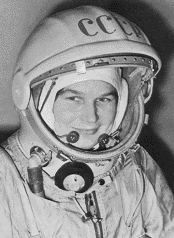

As the respective Mercury and Vostok projects ended, Russia still seemed to be ahead in the space race. However they were increasingly becoming reliant on headline making flights.
The Americans now moved on to project Gemini.
The Gemini spacecraft would be used to plot the course to the moon.
Chapter 5 - Walking in Space
Before the Gemini project could get off the ground, the Russians, who were becoming masters at pulling the rug from under NASA's feet came up with another space first. Cosmonaut Leonov left his spaceship and high above the earth became the first human being to perform a spacewalk. To rub salt in the wound Pravda also announced that Voshkod was the first 3 man spacecraft and took great joy in pointing out that the Americans were still three years away from producing their 3 man Apollo capsule. The headline said 'SORRY APOLLO'.
The truth was the Russians had managed to cram an extra cosmonaut into their two man craft in order to create another first.
For the American Gemini missions, nine more astronauts were added to the original Mercury 7.
The missions started well. Gemini 3 proved how manoevrable the craft was. Gemini 4 included the first American spacewalk. Gemini 5 stretched the flight duration record to eight days and Gemini 7 increased it to fourteen.
Gemini 6 and 7 were the first spaceships to rendevouz in space, moving to within a few inches of each other.
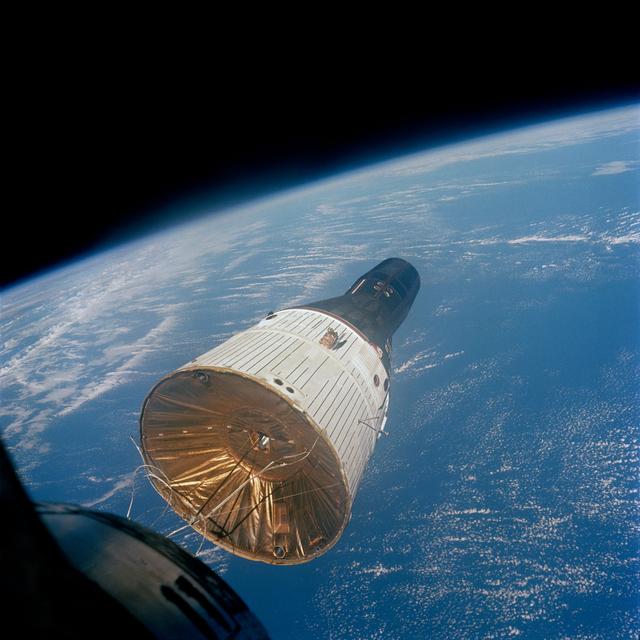

The objective for Gemini 8 was to dock with an unmanned Agena spacecraft that had been put into orbit hours earlier. The mission was piloted by Neil Armstrong and Dave Scott and it would nearly cost them their lives.
The docking manoeuvre was a success but as the coupled ships flew high over China they began to spin out of control. There seemed to be a problem with the Agena spacecraft and as the spin rate climbed Armstrong was forced to undock from the unmanned spacecraft. This just increased the spin rate of the Gemini. One of the thrusters was stuck open and the Agena had actually been holding the two craft steady. Once uncoupled the Gemini started to spin wildly out of control. The astronauts were fast reaching the point where they would become unconscious and die. Armstrong hit the re-entry rockets and slowly the spin rate dropped. It took the astronauts another half an hour before they could bring their Gemini under control.
The ship was now low on fuel and Armstrong had to make an emergency re-entry out of range of the tracking stations that would guide them down to splashdown.
Armstrong's skill and coolness in an extreme emergency would not be forgotten when it came to flying the Apollo missions.
Gemini 9, 10 and 11 proved successful in knocking down the obstacles that stood between them and the moon....except one. Spacewalking was still giving the astronauts extreme problems and if that nut couldn't be cracked then the moon landings were no-go.
It was only on the final Gemini mission that an astronaut was able to learn from all the experiences and problems from previous attempts and finally showed that it could be done. That astronaut was Buzz Aldrin.
Gemini consisted of 10 missions in 12 months and had put the American space programme on course for the moon. It had also moved the Americans past the Russians who had achieved only one space walk and had yet to master manoeuvring a spacecraft in orbit.
The next step for the American programme was Project Apollo. This project would deliver the moon but there would be a heavy price to pay.
Chapter 6 - Fire in the Cockpit
Apollo I was a complicated spacecraft with thousands of systems that needed to function in harmony. It wasn't happening.
With thousands of systems came thousands of faults. By the start of 1967 there had been twenty thousand failures of one sort or another.
The first pre launch test was set for 27th January and the three astronauts selected to fly the first Apollo mission were Gus Grissom, Ed White and Gordon Chaffee.
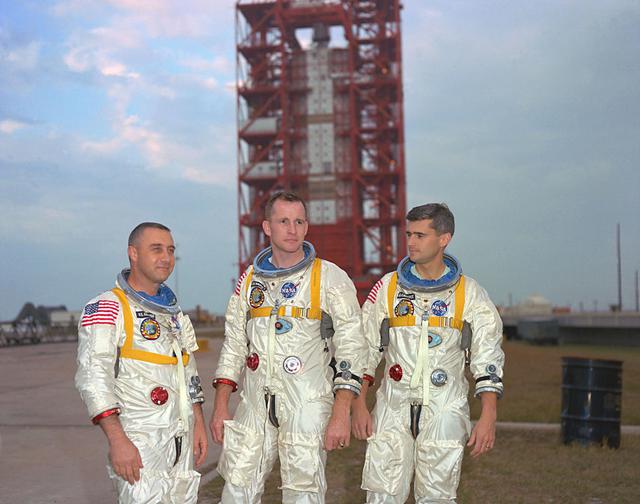

The three astronauts were suited up and would run through all the procedures in a dress rehearsal for the launch. They were sealed in Apollo I and the capsule was pumped full of pure oxygen prior to countdown.
It didn't take long before system problems started appearing and the astronauts started to lose patience with all the issues. When the communications system started to unwind, Grissom snapped, "If I can't talk with you only five miles away, how can we talk to you from the moon?"
Back in mission control engineers scanned monitors looking for the problems. Suddenly all the dials and gauges went crazy. A voice shouted "fire". It was the voice of one of the astronauts. The controllers looked at the screen that should be showing the interior of the Apollo capsule, all they could see was a fireball. Gus Grissom's voice came over the comms, "I've got a fire in the cockpit". There were more shouts , a scream and then silence. The interior of Apollo I had become a blowtorch and in eight seconds Grissom, White and Chaffee were dead. Everybody's worst nightmare had just become a reality.
Space exploration has always been inherently dangerous and the possibility of losing a crew always weighed on people's minds but to lose the astronauts on the launch pad in a test amplified the tragedy.
Apollo had become a mess. Complacency and incompetence was commonplace and in the wake of the Apollo I disaster a drive to improve things wholesale saw a lot of heads roll.
The Apollo program was temporarily shut down. The investigation into the fire condemned NASA for its lack of concern for safety and shoddy workmanship.
If the space program was to continue a new Apollo would have to be built and it would have to be as safe as they could make it. A new determination ran through the Apollo project.
It was a terrible tragedy that the fire happened but without it and the massive shake up that followed, Apollo would probably have failed to reach the moon.
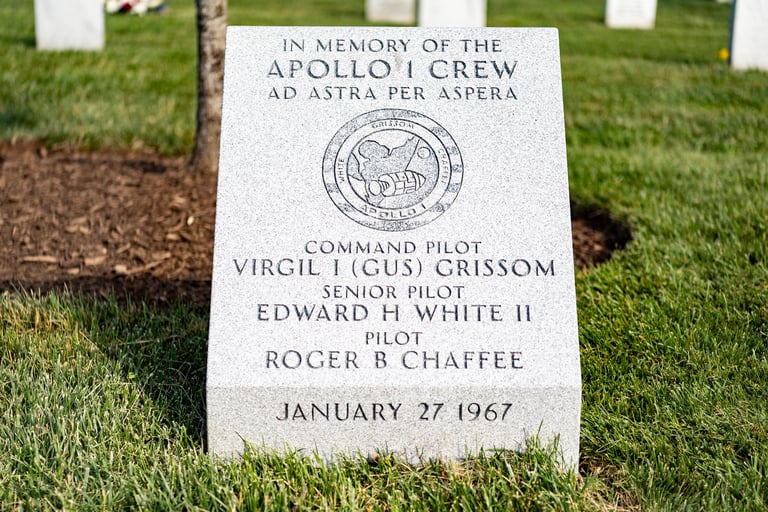

Chapter 7 - A Russian Tragedy
Eighty six days after the Apollo I fire, cosmonaut Vladimir Komarov was launched into space in the new Soyuz spacecraft.
This was the ship that would bring the Russians back into the space race. Not only did it have the handling capabilities of Gemini but it could also reach the moon.
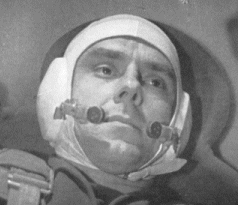

However, just like Apollo 1, Soyuz 1 was another spacecraft that had been beset by problems.
Yuri Gagarin was so worried about the dangers his friend Vladimir would face, that he tried to convince the Soyuz project managers that he should replace Komarov as pilot. His brave offer was refused.
After a perfect first orbit the Soyuz started to develop serious problems. By the thirteenth orbit system after system had fallen apart and the flight controllers feared for Komarov's life.
When the time came for re-entry there was nothing Komarov could do to stabilize his craft and it started a fatal descent back to earth. The parachutes failed and nothing could be done to slow the Soyuz down. Vladimir Komarov would be killed on impact with earth. His wife, Valentino Komarov was sent for and allowed a few private moments to speak to her husband for the final time. The Space Race had claimed another life.
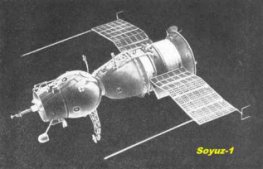

The Russian space programme stalled.
No Soyuz spacecraft would fly for another eighteen months.
Chapter 8 - A Trip to the Moon
At NASA the engineers were busy. While the new Apollo command and lunar modules were being designed, probes were being sent to the moon to determine potential landing sites. Meanwhile the first launch of the massive Saturn V rockets had proved successful. It had launched a payload of 280,000 pounds. This was more than the combined weight of all the previous probes and satelittes launched by the US.
Von Braun, the designer of the Saturn V rocket was ecstatic. At last he had created the interplanetary rocket he had dreamed of.
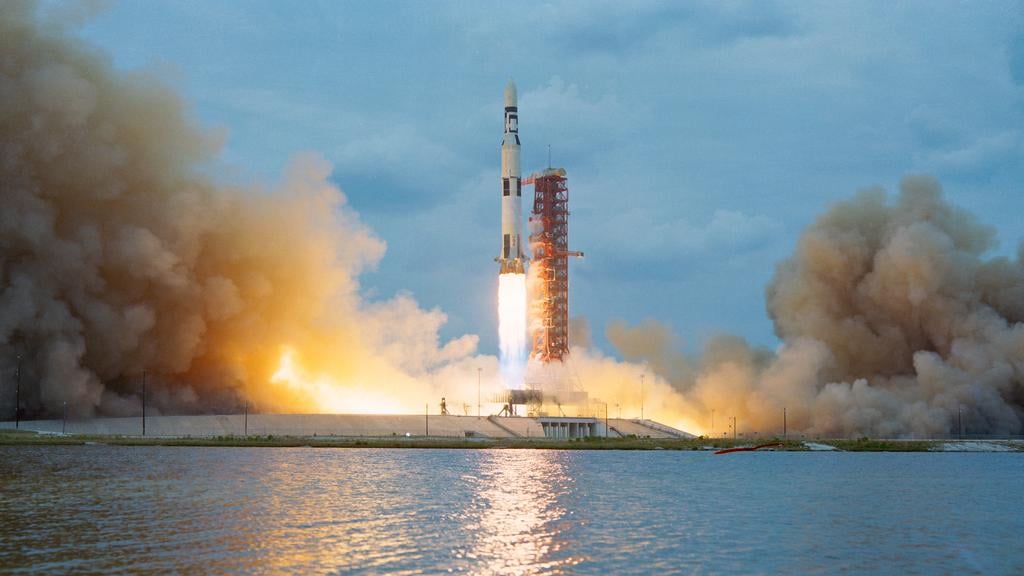

In October 1968 Apollo 7 lifted into orbit and the first American three man space flight was another tick in the right column.
Apollo 8 was due to test the Apollo command and lunar modules in earth orbit but by September 1968 CIA had intelligence that a Russian spacecraft called Zond was being prepared to send a cosmonaut orbiting around the moon. Without actually landing a man on the moon the Russians could claim to have reached it first. NASA decided to change the Apollo 8 program and send the three astronauts on board to the moon... for Christmas.
Once launched the crew of Apollo 8 were the first men to see the earth as a slowly shrinking globe as they blasted towards the moon. After travelling over half way to the moon they started to coast 'downhill'. This was the part of the journey where the pull of the moon's gravity was greater than the earth's.
To put Apollo 8 into lunar orbit the big retro booster on the spacecraft had to fire for 247 seconds. If it failed the Apollo 8 could slingshot around the moon and get a free ride home. If the booster failed half way through the burn then the spacecraft and its occupants would be sent out into deep space and certain death.
The booster would be fired when Apollo 8 moved behind the moon and out of radio contact with earth. It would only be when Apollo 8 reappeared from behind the moon that mission control would know whether they had achieved history or had just sent three men to their deaths.
Before the astronauts reached the moon's shadow they received the news they wanted to hear from mission control' "You are go all the way". Jim Lovell, the pilot of the command module replied, We'll see you on the other side" and the spaceship plunged into radio silence.
As the minutes ticked by, mission control kept up the radio call "Apollo 8....Apollo 8....Apollo 8" until finally it was answered by Lovell's call "Go ahead Houston". Mission control went wild, Apollo 8 was in lunar orbit.
It was Christmas eve and as the crew of Apollo 8 took it in turns to describe the surface of the moon, crew member Bill Anders closed his message with "and from the crew of Apollo 8 we close with good night, good luck, a Merry Christmas and god bless all of you - all of you on the good earth."
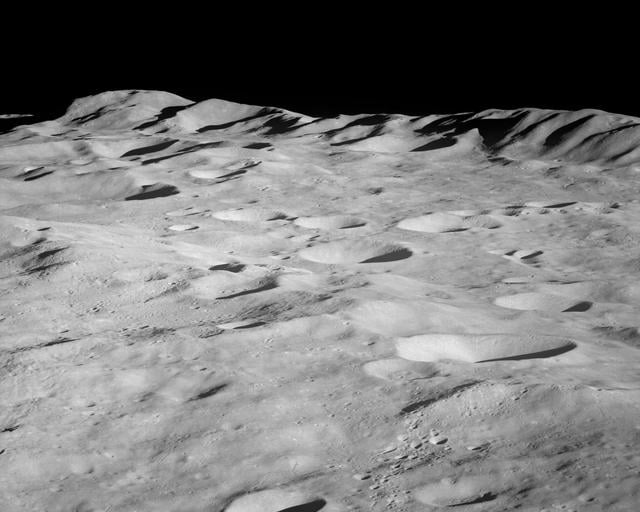

A photo of the moon's surface taken by the crew of Apollo 8 as they orbited the moon. The surface appears a lot closer than it actually is!
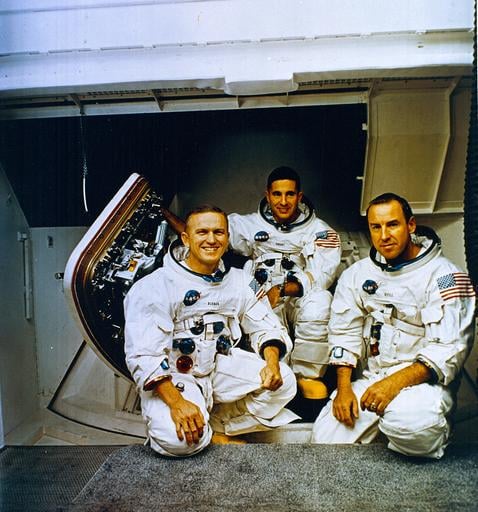

The crew of Apollo 8. From left to right, Frank Borman, William Anders and James Lovell.
Chapter 9 - The Dream Ticket
After the outstanding success of Apollo 8, there was now the question of which mission would be the first to land on the moon. Shortly after Apollo 8 was back down on earth, Deke Sleyton, the man in charge of the astronauts office, called the crew of Apollo 11 into his office. His message was simple, if Apollo 9 and 10 flew successful missions then Apollo 11 would be the first manned spaceship to land on the moon and one of the three astronauts would be the first member of mankind to set foot on the dusty surface. The crew of Apollo 11 had been given the dream ticket.
The job of the Apollo 9 crew was to test the landing module. Unfortunately for astronauts McDivitt and Schweickart these tests would be carried out in earth orbit so they would not be travelling to the moon. However the 10 days of testing they conducted were vital to the project. The Landing Module was the vehicle that would take Neil Armstrong and Buzz Aldrin to the moon's surface and these tests were designed to simulate the docking, undocking and maneuvering that would be required in lunar orbit. The mission was a success and project Apollo had taken another substantial step towards it's place in history.
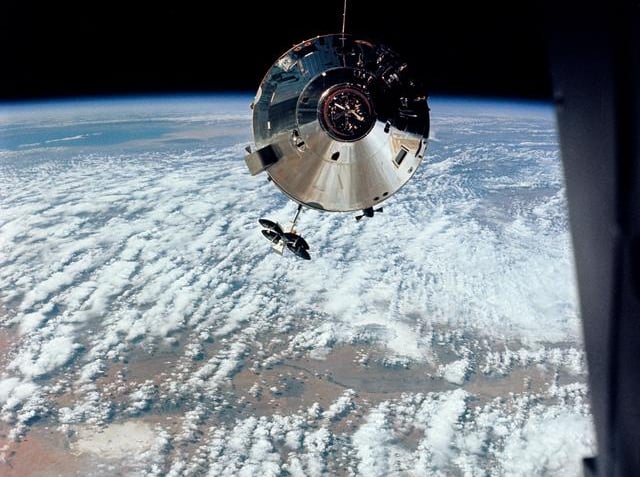

The Apollo 10 mission was the dress rehearsal for the moon landing. Astronauts Stafford, Young and Cernan would fly to the moon and while John Young waited in the command module (named Charlie Brown for this mission), Tom Stafford and Eugene Cernan flew the landing module (Snoopy) down to just 9 miles above the moon's surface. This allowed them to survey potential landing sites around the Sea of Tranquility before Charlie Brown and Snoopy were re-united in lunar orbit and Apollo 10 flew back to earth.
A photo of the earth taken by the crew of Apollo 10 from 100,000 miles away. The Apollo crews were the first people to be able to view their home planet from so far away in space.
Photo of the Apollo 9 Command Module flying over New Mexico. The photo was taken from the Landing Module.
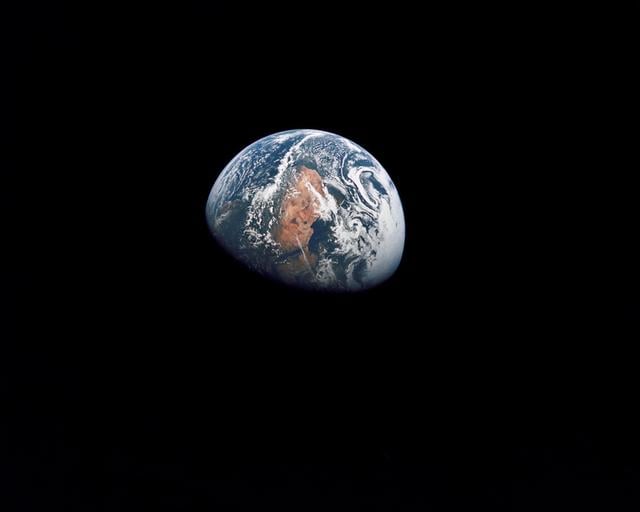

With Apollo 9 and Apollo 10 missions completed successfully the next two men to orbit the moon would also be landing on it.
Chapter 10 - The Eagle has Landed
In a spaceship called Eagle, Neil Armstrong and Buzz Aldrin watched the moon's surface slip by below them. Flying backwards with their faces parallel to the surface below they constantly scanned the instruments in front of them. Everything was looking good and they waited for Michael Collins in the command module flying way above them to give them the green light for the landing. Collins' words flashed into their headsets, "Eagle this is Columbia, they just gave you a go for powered descent."
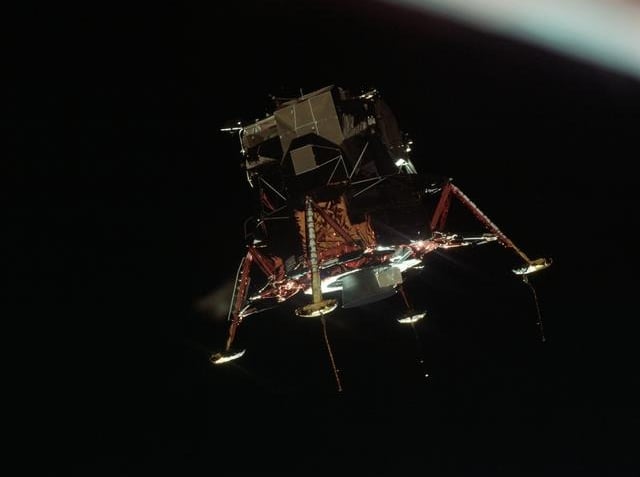

In Houston an army of technicians studied banks of consoles telling them the status of all the on-board systems on the Eagle. Gene Kranz was the flight director. He had the final say on all the decisions and he answered to the name "flight". Kranz hit the switch to talk to everyone in mission control, "Hey gang, we're really going to land on the moon today, no bullshit".
In the Eagle, Armstrong and Aldrin ignited the descent engine exactly 192 miles from the landing site. Thuds and bangs echoed around the ship as thrusters fired to hold the Eagle steady. Back at Houston, Steve Bales a 26 year old computer whiz kid scanned his monitors. To everyone else in the room his name was "guido".
Suddenly alarms went off both on Eagle and back in Houston. At six thousand feet above the moon Buzz Aldrin read out the numbers in front of him. "Program alarm, we've got a 1202". The Eagle's computers were overloading and the 1202 alarm was a cry for help. All eyes turned to Steve Bales. Everyone sensed an abort, but Bales had to make the call. Armstrong asked for a response. "Give us a reading on that 1202". Bales needed time but Kranz needed the answer. He stared at Bales and slammed his fist into the console. Bales made his call "Go". The message was relayed to Armstrong, "We're go on that alarm, Eagle."
At two thousand feet the alarms went off again. This time it was a 1201. Another overload alarm. Kranz shouted at Bales "Guido what about it?". "Go, just go" came the response.
The message was passed on a quarter of a million miles "We're go, Eagle, hang tight we're go".
At thirteen hundred feet, Neil Armstrong took manual control of the Eagle. The computers had done their bit now it was down to Armstrong to fly to the moon's surface. Looking out of the small window, he expected to see the same surface features that he had seen in dozens of flight simulations. They weren't there. Eagle had overflown the landing site by four miles. Armstrong was looking at a boulder filled crater and his spaceship was running out of fuel.
As Armstrong flew the ship Aldrin called out the numbers, altitude, speed, fuel. There was nowhere to land. Armstrong pitched the Eagle to the left and spotted a site where the boulders thinned out. Eagle only had 90 seconds of fuel left. Having got this far they were perilously close to aborting the mission.
Mission control could see the fuel was down to sixty seconds and couldn't understand why the Eagle had not landed. Kranz keyed his mike, "This is flight, you'd better remind them there ain't no gas stations on the moon." This message was relayed to Eagle in three words, "Eagle thirty seconds". Aldrin's hand hovered over the abort button. They were now only 50 feet above the moon but their fuel was almost exhausted. In Houston a sense of panic was setting in. The Eagle was now too close to the moon's surface to abort. By the time the ascent engines kicked in they would have crashed on the moon. They had no get out clause and no fuel.
Everyone listened to the astronauts words,
"Two and a half down"
"Kicking up some dust"
"Faint shadow"
"Four forward"
"Drifting to the right a little"
"Contact light"
"Okay engine stop...descent engine command override off"
Houston responded "we copy you down Eagle".
All the consoles showed that they had landed but Houston needed voice confirmation. Neil Armstrong allowed himself a second to catch his breath and then sent word home.
Three seconds and two hundred and fifty thousand miles later his voice came through at mission control, "Houston, Tranquility Base here. The Eagle has landed".
Above the cheering Charlie Duke spoke for all at mission control, "Roger Tranquility. We copy you on the ground. You've got a bunch of guys about to turn blue. We're breathing again. Thanks a lot"
As the astronauts looked out at the desolate landscape before them, Charlie Duke back at mission control opened the microphone so that the they could hear the celebrations in Houston, "be advised there's a lot of smiling faces in this room...and all over the world.
Photo taken of 'Eagle', the landing module for Apollo 11. The photo was taken by Michael Collins from the Command Module that remained in moon orbit during the moon landing.
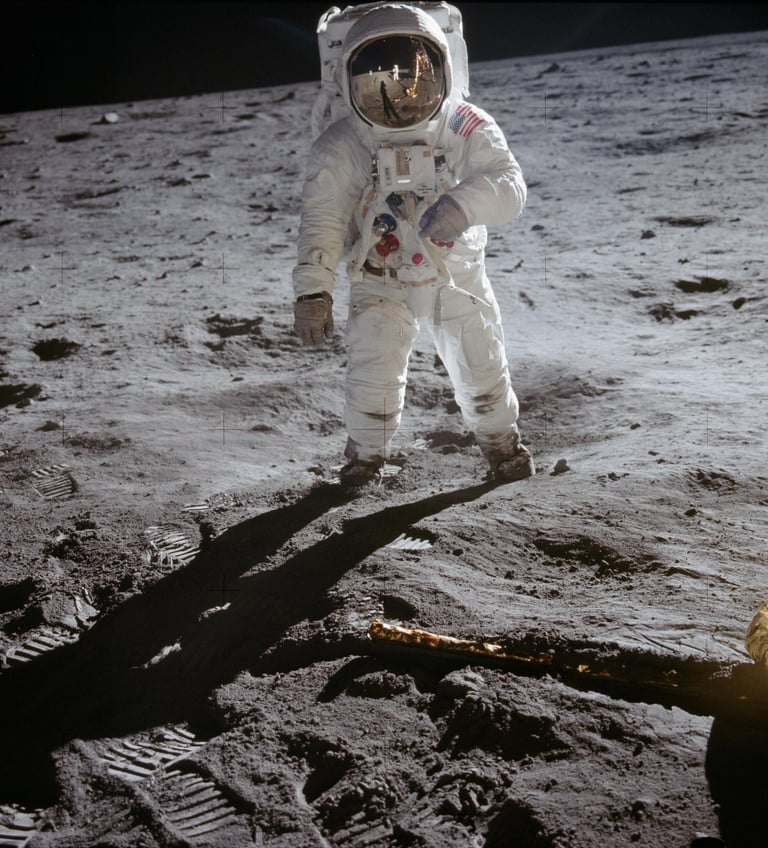

Note from the author:
The moon landings must still rate as one of the most remarkable and inspiring stories in human history.
If you have found this very brief account of the space race interesting then I hope you are inspired to dig deeper and learn more as there is so much I have missed out.